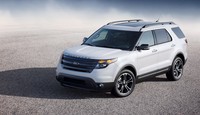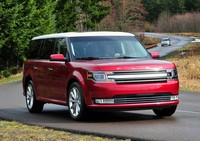Ford Space Solutions - 2013 Ford Explorer Sport and Ford Flex Limited AWD Reviews By Carey Russ
DRIVING DOWN THE ROAD
WITH CAREY RUSS
Ford Space Solutions: 2013 Explorer Sport and Flex Limited AWD
Do you need a vehicle with space for people and things and the ability to tow maybe a couple of tons of trailer? A couple of decades ago, years ago you'd be buying a truck-based utility vehicle and enduring the rough ride, noisy interior, and lack of creature comforts. Now, you have a great variety of choices, and, other than pickups, it's hard to find a "truck" that's a rough, basic, body-on-frame machine.
How'd that happen? The Ford Explorer. The Explorer was a new paradigm in personal transportation when it debuted in 1990. While still a body-on-frame truck at heart, it was meant first and foremost as personal transportation for city and suburban people, not as a blue-collar work truck. If not the first "sport" utility vehicle, it quickly became the benchmark in the burgeoning midsize SUV class, and helped establish the SUV as the American vehicle of the 1990s. Along the way it grew in size and was distanced from its pickup-based origins. By 2002 it even shed the truck solid rear axle in favor of a fully-independent suspension for more car-like ride and handling.
Nothing is as constant as change, and even the SUV fad faded. Kind of -- SUVs were replaced by crossovers, the term originally denoting a vehicle that was a cross between a car and truck. Meaning car-like unibody construction for improved interior space utilization and lower step-in height, car-like independent suspension for comfort and handling, and an SUV-like shape. Or not, as crossovers came, and continue, in a wide variety of shapes and sized. Ford's first crossover was the boxy Edge, followed by the wagon-like Flex. And starting in 2011, the Explorer technically joined the crossover ranks, as the fifth generation was based on the D4 platform that also underlies the Flex. And both are cousins to the Taurus sedan.
During the last week I spent four days with the newest addition to the Explorer line, a 2013 Explorer Sport, and then three days with a Flex, in premium Limited AWD trim. If the Explorer Sport name is familiar as the two-door variant from the 1990s, that was then. Two-door SUVs are mostly historical footnotes now. "Sport" now means top-of-the-line with special exterior and interior trim, AdvanceTrac all-wheel drive with the multi-drive mode Terrain Management System, a firmer tuning to the fully-independent suspension and larger brakes to take advantage of chassis reinforcements, and revised electrically-assisted power steering with a firmer touch. And four doors. Power, 365 horses worth, is exclusively from the 3.5-liter, twin-turbo "EcoBoost" V6 matched to a six-speed automatic transmission with manual-shift mode via paddles on the steering wheel.
The Flex Limited that was my second test car was similarly outfitted, AdvanceTrac AWD, EcoBoost engine and six-speed sport automatic, and all the luxury trimmings. Standard and optional equipment levels were different, no surprise, but both were configured similarly, with leather, navigation, a 390-watt Sony audio system with Sirius satellite radio, Sync with MyFordTouch, power liftgate, blind spot and cross-traffic monitoring, backup camera, pushbutton start/stop with remote starting, and three-row seating. And more…
Compare and contrast, as the old school exercise goes… Ford's big-but-not-huge people-movers are more alike than different. Surprisingly, the Flex has a longer wheelbase, 117.9 inches to 112.6, and overall length, 201.8 inches to 197.1. The Explorer is wider, 90.2 to 88.8 inches including mirrors, and taller, 71 to 68 inches. The Explorer wins on ground clearance, at the price of a higher step-in, but that is part of the Explorer style. Neither vehicle is meant for serious off-road use, and the Flex's exhaust system sits no more than six inches from the pavement so plowed snow and improved forest roads, yes, back-of-beyond four-wheeling, Not Even. With eight or so inches to the expensive parts, the Explorer is a better choice for semi-wilderness or the potholes and road debris of semi-civilization.
Inside, headroom in both is within fractions of an inch, as is legroom except that the Flex wins hands-down for the second row, 44.3 to 39.8 inches. The Explorer wins shoulder and hip room, but not by much and not in the third row. The Explorer is fractionally smaller in passenger volume but bigger in overall volume, but only in a way that matters to someone who wants their car with ping-pong balls.
Realistically, the difference between the two comes down to style. The Explorer Sport is an Explorer, with a classic SUV look that's not unlike some high-end British machinery once owned by Ford. And the Sport builds on that with a low-gloss black grille and matching 20-inch alloy wheels and smoked headlight covers, among other unique features. The Flex is the closest thing to a standard American station wagon in the Ford lineup, and in some ways not dissimilar to an updated 1955 Ford wagon. Except for the front, new this year, which looks right out of the movie Tron thanks to the angular motif. "FLEX" is proudly displayed on the hood and liftgate, with only a small blue oval on the liftgate to denote the manufacturer.
Inside, as mentioned space is similar, and not lacking. Yes, access to the third row can be a bit tricky, although this Flex had power (down only) flip and fold second-row buckets to the Explorer Sport's 60/40 bench so easier access. Both third rows are best thought of as for small people for short times, no demerits as the same applies to the competition. The front sport seats in my Explorer Sport beat the seats in my Flex, personal opinion only. Both are good, and power-operated, heated, and cooled at this level. The cooler compartment in the Flex's rear console was a useful touch. Ingress/egress is a bit easier in the lower Flex, but a stepladder is not necessary for the Explorer.
Both use Ford's latest "glass cockpit" MyFord Touch® multi-configurable instruments and controls. The system has been modified for easier use this year, and the software upgrade for that is being offered to existing customers as well. There is a learning curve, as there are plenty of information choices. If you're familiar with the newest electronic device interfaces, you'll adapt quickly.
Power is never a concern with the EcoBoost V6. Use of direct fuel injection allows a high compression ratio (10:1) even with turbocharging, for improved efficiency. And power -- the horsepower maximum, 365 at 5500 rpm gets attention, but it's the torque -- 350 lb-ft at 3500 rpm with not much less from right above idle through all commonly-used engine speeds that's impressive. Acceleration and fuel economy are also improved by use of a six-speed automatic transmission, which has manual shifting but that's rarely going to be necessary thanks to all that torque. The Flex is only about a hundred pounds lighter than the Explorer Sport, with the same gearing in the transmission and final drive, so acceleration and fuel economy are similar. Figure 0-60 in the six-second range, which ought to surprise more than a few people at the stoplights. Do that much, and watch the gas gauge drop quickly. More reasonable driving got me 18 mpg overall for the Explorer, with more than the usual amount of highway travel, and 17 for the Flex, with very little highway use.
"Road manners" was not a term used positively in reference to early Explorers. My how times have changed. The Sport's suspension is very European in feel, compliant but firm, with harshness only when the highway department hasn't been doing its job. Even on a twisting and hilly mountain road, there is actual sport here to go with the utility, and the near-5000 pound mass seems to vanish. Upgraded brakes are up to the job at hand. The Flex lacks a Sport version but still drives like a good car, and is quite capable when the road gets interesting. The Explorer wins towing, with a 5000-pound capacity to the Flex's 4500, but both should be capable of towing a large variety of boats or trailers.
Good handling and quick response are safety factors as well as fun factors, a plus for active safety. Passive safety equipment includes all of the expected airbags, crumple zones, and electronics, including available blind spot monitoring with cross traffic detection, alarms, and tire-pressure monitoring, all of which were fitted to both test vehicles. So were second-row inflatable shoulder straps, which provide a bit of airbag cushion for those passengers in an accident.
With both the new Explorer Sport and the latest Flex in Eco-Boosted Limited AWD trim, Ford is putting some real sport in "sport utility", and not at the expense of utility. Or fuel economy, all things considered -- which is as good or better than older, smaller, slower ancestors.
SPECIFICATIONS 2013 Ford Explorer Sport (2013 Ford Flex Limited AWD if different)
Base Price $ 40,720 ($ 43,850)
Price As Tested $ 46,640 ($ 49,790)
Engine Type DOHC 24-valve twin-turbocharged and
intercooled aluminum alloy V6 with
direct fuel injection
Engine Size 3.5 liters / 213 cu. in.
Horsepower 365 @ 5500 rpm
Torque (lb-ft) 350 @ 3500 rpm
Transmission 6-speed automatic with manual-shift mode
Wheelbase / Length 112.6 in. / 197.1 in. (117.9" / 201.8")
Curb Weight 4921 lbs. (4839 lbs)
Pounds Per Horsepower 13.5 (13.3)
Fuel Capacity 18.6 gal.
Fuel Requirement 87 octane unleaded regular permissible
with reduced power,
91 octane unleaded premium for best
performance
Tires P225/50 R20 104H (P225/45 R20 101V)
Hankook Optimo 426
Brakes, front/rear vented disc all around, ABS,
AdvanceTrac® stability control standard
Suspension, front/rear independent MacPherson strut /
independent multilink
Drivetrain single-range 4-wheel drive with
Terrain Management (all-wheel drive)
PERFORMANCE
EPA Fuel Economy - miles per gallon
city / highway / observed 16 / 22 / 18 (16/ 23/ 17)
0 to 60 mph est 6 sec
Towing Capacity, lbs 5,000 (4,500)




